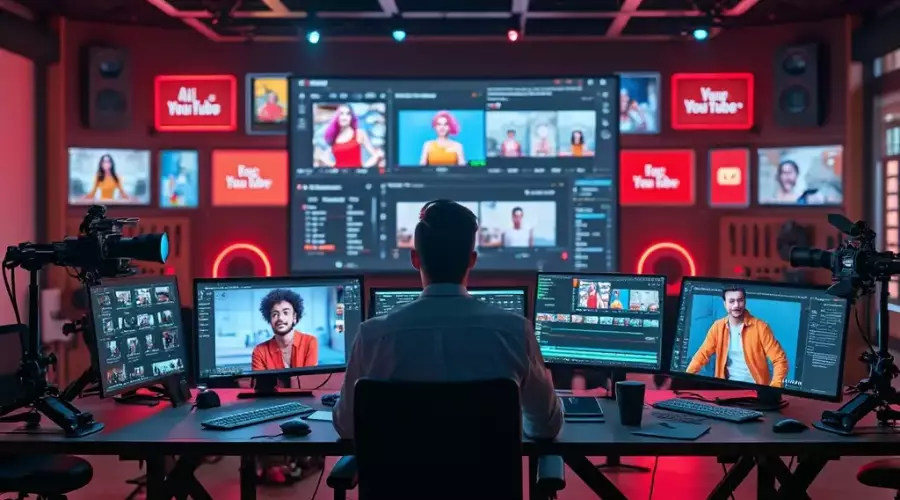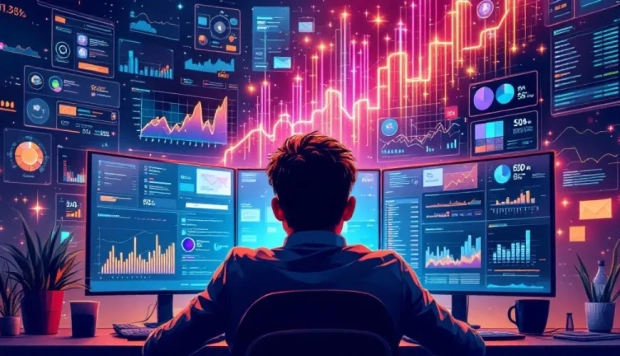How to Use AI Tools in Content Creation: A Complete Guide

Artificial Intelligence (AI) is transforming how content is created, distributed, and consumed. From writing blog posts and generating images to editing videos and optimizing content for SEO, AI has become an indispensable assistant to creators across industries. Whether you're a solo YouTuber, a marketer, or a creative agency, leveraging AI tools can save time, enhance creativity, and boost productivity. Behind many of these AI tools, there are platforms like AyaData, which provide high-quality labeled data, AI consulting, and generative solutions, helping train and deploy the latest content-generation systems effectively.
In this guide, we'll explore the major ways AI is used in content creation, the best tools in each category, and actionable strategies to integrate them into your workflow - with a special focus on video content creation using AI.
Why AI Is a Game-Changer for Content Creators
Traditionally, content creation was a labor-intensive process that demanded extensive resources and time. Today, AI streamlines this work by automating repetitive tasks, assisting in ideation, and even executing creative functions like writing, design, and voiceovers.
Here's why content creators are increasingly turning to AI:
- Speed: AI can generate ideas, outlines, or even full drafts in seconds.
- Cost-efficiency: Reduces the need for large teams or outsourcing.
- Scalability: Enables batch content production for multiple platforms.
- Consistency: Maintains tone, brand voice, and style across projects.
- Inspiration: Helps overcome creative blocks with suggestions and variations.
Now, let's break down how to use AI tools across different content formats.
1. AI for Text Content
AI writing assistants have matured significantly, making them excellent partners for generating:
- Blog posts
- Product descriptions
- Social media captions
- Email newsletters
- Ad copy
Recommended Tools:
- ChatGPT: Great for long-form content, ideation, or Q&A-style responses.
- Jasper: Ideal for marketing copy, tone adjustment, and SEO optimization.
- Copy.ai: Efficient for quick copywriting tasks like taglines or meta descriptions.
- Grammarly: Enhances grammar, clarity, and tone for AI-generated text.
- HumanizeAI: Enhance Your Writing Instantly with Free AI Sentence Expander.
How to use it effectively:
- Begin with a structured prompt or outline.
- Let AI generate a rough draft.
- Edit and infuse it with personal experience, insights, or data.
- Use AI again to polish the final draft and adjust tone or length.
Pro Tip: AI tools are most effective when paired with human judgment. Treat AI-generated text as a draft, not a finished product.
2. AI for Image and Design Content
Designing thumbnails, infographics, banners, and social media visuals is faster with AI tools. Many platforms now offer drag-and-drop interfaces powered by machine learning and prompt-based generators.
Recommended Tools:
- Canva with Magic Design: AI-suggested layouts and design variations.
- Adobe Firefly: Text-to-image generation for creative or surreal designs.
- Midjourney / DALL·E: Generate unique illustrations or backgrounds.
- Looka / Brandmark: AI-based logo creation.
Use Case: Want to create a thumbnail for a YouTube video about space travel? Describe the scene to DALL·E or Midjourney and generate a stunning visual that you can refine in Canva.
Design Tip: Use AI for visual brainstorming or background creation, but keep overlays, branding elements, and focal points consistent manually for better brand recognition. Before finalizing your visuals and brand kit, use an Instagram Username Availability Checker to secure a consistent @handle and protect brand discoverability across platforms.
3. AI for Audio Content
From podcast editing to AI-generated voiceovers, AI is revolutionizing how we produce and manage audio content.
Recommended Tools:
- Descript: Turn audio into text, edit audio by editing text, remove filler words automatically.
- ElevenLabs: Generate realistic voiceovers with natural intonation.
- Adobe Podcast: Enhance audio quality with one-click cleanup tools.
Workflow Suggestion:
- Record your voice or script.
- Clean up the audio using Adobe Podcast.
- Use Descript for transcript editing and repurposing.
If needed, generate voiceovers using ElevenLabs with multiple voice styles.
Creative Use: AI voice cloning can be used for narration in different accents, characters, or languages without hiring separate voice artists.
4. AI for Video Creation
One of the most exciting applications of AI in content creation is in video production - whether for YouTube, TikTok, reels, or ads. AI can assist with scriptwriting, editing, creating animated marketing videos, faceless content, and even full automation of video channels.
How to use AI for video creation:
- Scriptwriting: Use AI writers like ChatGPT or Jasper to generate compelling video scripts based on trending topics or keywords.
- Voiceovers: Generate voice narration with tools like ElevenLabs or Murf AI.
- Stock footage or AI animation: Tools like Pictory, Lumen5, and Synthesia let you create videos using stock clips, avatars, or animated visuals.
- Editing: Use Magisto, Wisecut, or Runway to automate jump cuts, music syncing, subtitles, and more.
- Automation: For fully automated video channels, AI can handle ideation, script generation, visuals, and even scheduling.
For those interested in creating a faceless YouTube channel, AI tools like Synthesia (for talking avatars) or Pictory (for stock-footage-based narration) make it easy to build high-quality, human-sounding videos without ever appearing on camera.
And if you're just getting started, we also recommend this guide on how to create a YouTube channel - from naming to branding to uploading your first AI-powered video.
5. AI for Repurposing Content
Smart creators use AI not only to generate new content but also to multiply existing assets.
Use Cases:
- Turn YouTube videos into blog posts using transcription and summarization tools.
- Convert webinars into Instagram reels or LinkedIn carousels.
- Republish old articles with fresh insights using AI rewriting tools.
Recommended Tools:
- Repurpose.io: Automates conversion of long-form content into clips for social platforms.
- Otter.ai: Transcribes and summarizes meetings, podcasts, or videos.
- QuillBot: Paraphrases or rewrites text in new styles or tones.
Strategy: Create once, distribute everywhere. AI helps you adapt content formats to fit each platform's algorithm without starting from scratch every time.
6. AI for SEO and Optimization
AI also plays a major role in helping your content get discovered. It can suggest keywords, generate meta descriptions, and even write SEO-friendly outlines.
Recommended Tools:
- SurferSEO: Real-time SEO recommendations for blogs and pages.
- RankMath + GPT integration: For WordPress-based websites.
- TubeBuddy / vidIQ: AI-driven keyword research and title optimization for YouTube.
AI Use Tip: Combine keyword research from SEO tools with content generation from AI writers to create discoverable, high-ranking content faster. While DIY tools provide a solid foundation for YouTube optimization, content creators looking to maximize their channel growth often benefit from professional YouTube SEO services that offer comprehensive strategies including advanced analytics, competitor analysis, metadata optimization, and ongoing performance tracking to ensure sustained visibility in YouTube's competitive algorithm.
7. How to Use AI Safely and Ethically
As AI tools become more powerful and accessible, using them responsibly is just as important as using them creatively. AI can supercharge your workflow, but misusing it - intentionally or unintentionally - can lead to misinformation, plagiarism, loss of trust, or even copyright violations. Many websites and companies now have systems for detecting AI to make sure the content people share is real and honest. That's why you should always use AI carefully and tell the truth about how you use it.
Here's how to ensure your content creation remains safe, ethical, and aligned with platform guidelines:
A. Verify Information Before Publishing
AI tools can generate content that sounds authoritative but includes incorrect or outdated information. Always:
- Double-check facts, dates, and statistics against trusted sources.
- Use AI as a drafting tool, not a final editor.
- Avoid using AI to create misleading narratives or fake news, especially in sensitive topics like health, finance, or politics.
B. Disclose AI Usage (When Appropriate)
Transparency builds trust. If your audience expects a human voice - in writing, speaking, or visuals - and you've used AI-generated components (e.g., voiceovers, scripts, or avatars), consider disclosing that.
Examples:
- "Script assisted by AI tools.”
- "Voiceover generated with AI.”
This is especially important in educational, journalistic, or public-facing content.
C. Respect Copyright and Intellectual Property
AI tools often generate content based on training data scraped from the internet. While many tools claim to produce original outputs, some ai generated images may closely resemble existing works. To stay safe:
- Avoid replicating specific creators' styles or phrases unless explicitly licensed.
- Use licensed tools that guarantee rights to commercial use.
- When using AI-generated music, ensure it is royalty-free or comes with a usage license.
When in doubt, treat AI output like stock content: if you didn't create it from scratch, you may need to verify your rights to use it commercially.
D. Avoid Deepfakes and Identity Misuse
Tools that let you clone voices, faces, or personalities have immense creative potential - and serious ethical risks. Never use someone's voice, face, or likeness without consent, especially in content meant for monetization or public distribution.
If you're building a faceless YouTube channel using avatars or synthesized voices, opt for tools that use fictional or fully licensed characters and voices.
E. Comply with Platform Policies
YouTube, Instagram, TikTok, and other platforms are actively updating their policies around AI-generated content. For example:
- YouTube requires disclosure if synthetic media could mislead viewers.
- Monetization may be restricted for fully AI-generated content with minimal originality or human input.
- Content that uses AI to impersonate others or spread misinformation may be removed or demonetized.
Before scaling your AI YouTube channel, take time to review YouTube's community and monetization guidelines to ensure your automation strategy won't backfire. Familiarizing yourself with the YouTube monetization criteria is also crucial, especially when using AI-generated content, as failing to meet these standards can result in demonetization or content or channel removal.
F. Use AI as a Creative Partner, Not a Replacement
Finally, think of AI not as a shortcut to avoid effort - but as a tool to enhance your creativity and reach. Your unique voice, perspective, and storytelling ability are what truly build a loyal audience. AI should support, not replace, that authenticity.
Ethical tip: Credit your team and tools. Whether human or digital, giving credit where it's due reinforces transparency and collaboration.
Final Thoughts: Embrace the AI-Powered Creator Era
AI isn't here to replace human creativity - it's here to amplify it. When used wisely, it can eliminate bottlenecks, enhance your content quality, and free up your time for strategic and imaginative thinking.
Here's a recap of how to start:
- Start with your core format (text, video, audio).
- Choose 1–2 AI tools to integrate into your workflow.
- Experiment on low-stakes projects to learn how to prompt and refine.
- Measure results - is your content creation faster, easier, or more impactful?
- Iterate and scale your content machine using what works best.
From creating a faceless YouTube channel to fully automating a YouTube channel with AI, the possibilities are growing daily. AI tools aren't just add-ons - they're quickly becoming essential instruments in the modern creator's toolkit.
The future belongs to those who create smarter, not harder. And with AI on your side, you can turn your vision into reality faster than ever before.



